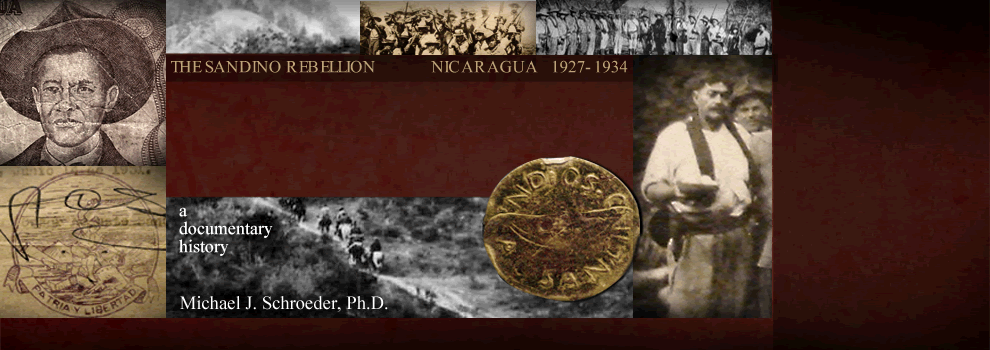|
Quilali, Nicaragua.
January 31, 1928
[actually December 31, 1927]
|
From: |
Commanding Officer, Special
Expedition against Chipote. |
|
To: |
The
Brigade Commander. |
|
Subject: |
Engagement with bandits. |
1. At about 0930,
January December 30, 1927, while
marching on Quilali, this expedition
encountered a bandit force of Sandino,
estimated at 400 to 500 strong on the
Camina [Camino] Real, about 1500 yards
south of Quilali. The action continued
on for about one hour and twenty minutes
when the enemy was driven off.
2. At the time the enemy force was
encountered, this force was marching
single file on a narrow trail along the
side of a mountain with the Jicaro river
on our left (west) flank. The mountain
sloped at an angle of about 45 degrees
and the slope from the trail to the
river 100 feet below us was about the
same. The river at this point was about
200 feet wide and made a sharp turn to
the west, and side of the mountain, and
a hill directly ahead flanking the trail
at the bend was covered with woods and
extremely heavy underbrush. A sketch,
showing the general situation, not to
scale, is enclosed.
3. As our point passed point "A", a
midway point to "B", it observed
suspicious movements at point "B". Fire
was immediately opened by enemy from
point "A" and "B" all along the line
"C", and from across the river from
point "E", with machine guns, automatic
rifles, rifles, pistols, dynamite bombs,
and unidentified weapons sounding
similar to our trench mortars and
mountain batter guns. Enemy guns and
riflemen were cleverly concealed; the
riflemen being along the barbed wire
fence on the mountain slope, each man
being ab behind an individual barricade
of rocks piled around tree stumps about
15" high and wide. Fire was opened
simultaneously from all points by the
enemy on discovery of this point at "B",
but it is believed that this was not in
accordance with his plans as our
examination of the trail north of "B"
disclosed that he had prepared positions
along the trail thru a banana grove, and
it is believed that it was his plan to
allow the advance guard to enter the
trail in the banana grove, and strike
the entire column simultaneously. The
discipline maintained, the morale, and
the accuracy of fire of the bandits, as
well as the tactical disposition of
their troops were far above anything
displayed by them in any of their
actions heretofore in this section and
leads to the belief that they are
receiving training from sources other
than Nicaraguans because of the
up-to-dateness of their tactics. All
enemy seen were garbed in clothing
similar to our summer field in color. No
prisoners could be captured because of
the superiority of the enemy's position
and the fat that they removed their
casualties with them. [ p. 2 ]
4. (a) Bandit leaders unknown.
(b) No mounts seen.
(c) Aerial assistance - none of our
planes were present during engagement
but two planes arrived immediately
after, strafed the hills in the
direction given by us and departed.
5. CASUALTIES:
Marines:-
(a) KILLED: HEMPHILL, John W. 1st Sgt.
(Lt. GN)
THIEIHART, Adolph Cpl.
GOLDSMITH, George E. Pfc.
WATSON, Grady W. Pfc.
CROSSON, Estler Pvt.
(b) WOUNDED, seriously-
LIVINGSTON, Richard Captain
CORYALL, Fred Gy-Sgt.
COLLINS, Robert H. Pvt.
TURNER, Charles E. Pvt.
COYNE, Berhnard W. Pvt.
SMITH, Leonard J. Pvt.
(c) MINOR WOUNDS - Fragments of bombs,
etc.
MINNICK, William T. Lt. (MC) USN
ROOS, Otto N. Sgt.
GOULD, Moses, J. 1st Lieut.
FIELDS, Scott Sgt.
NEEL, John W. Cpl. (Lt GN)
LEACH, Anthony J. Cpl.
BRANDENBURG, Raleigh R. Pfc.
DOWD, Thomas F. Pfc.
BLANCHARD, Harry M. Pfc.
LITTLE, Jacob Pvt.
FITZPATRICK, Arthur L. Pvt.
NEWBURGER, Albert H. Pvt.
ENDRESS, Clifford C. Pvt.
MERCHANT, William C. Pvt.
HUSKA, Paul Pvt.
SMITH, Glenn Pvt.
WALKER, Edgar, B. Pvt.
GUARDIA -
(a) KILLED: HEMPHILL, John W. Lt. (See
above under Marines)
HERNANDEZ, Enriques Cpl. #356
(b) Wounded seriously:-
GARCIAS, Louis C. Pvt. # 49
GUTIERREZ, Policarpo Pvt. #355
(not expected to live)
[p. 3]
(c) WOUNDED, not seriously:
NEEL, John N. Lt. (See above under
Marines)
NATIVE GUIDE:
Killed: SALINI, Ramon.
BANDITS:
Losses unknown, but believed to be
heavy.
PRISONERS:
None.
(6) Medical Officer considers it
necessary that all listed as seriously
wounded be evacuated immediately because
of lack of facilities for proper care.
(7) Pack train badly shot up and
scattered, report of losses of stores
and animals will follow later.
(8) No losses of ammunition or weapons
known at present. Check up being made.
(9) Check of ammunition expenditures
being made.
(10) Further details later.
(11) Dead will be buried here.
(12) Captain Livingston was wounded
immediately after action started and the
undersigned has assumed command pending
arrival of Lieutenant Richal.
M. J. GOULD,
1st Lieutenant, USMC,
Commanding.
Sketch of Scene of Action
Capt. Livingston's Column
30 December 1927.

NA127/212/1 and /113C/12
See also Neill Macaulay, The Sandino
Affair (Duke 1985), pp. 99-100.
|

